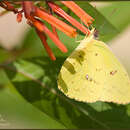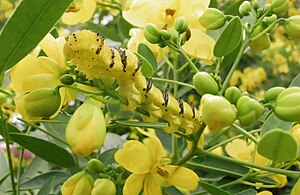mk
имиња во трошки


Phoebis sennae ye una especie de caparina, de la familia Pieridae, que foi descrita orixinalmente col nome de Papilio sennae, por Linnaeus, en 1758, a partir d'exemplares procedentes de Xamaica y Surinam.[2][3][4]
Phoebis sennae ta distribuyida ente les rexones Neotropical, Neártica y foi reportada en 30 países.[5][6][7][8].
Les canesbes de Phoebis sennae aliméntense de plantes de les families Brassicaceae, Salicaceae y Fabaceae. Ente les plantes güespedes reportaes atópense Casearia sylvestris, Cassia ferruginea, Cassia fistula, Chamaecrista chamaecristoides, Chamaecrista fasciculata, Chamaecrista nictitans, Crotalaria agatiflora, Senna alata, Senna armata, Senna bicapsularis, Senna corymbosa, Senna covesii, Senna arispia, Senna marilandica, Senna obtusifolia, Senna occidentalis, Senna uniflora, Chamaecrista cinerea, Senna tora, Desmodium incanum, Senna atomaria, Senna cobanensis, Senna hayesiana, Senna pallida, Senna papillosa y especies ensin identificar de los xéneros Phaseolus y Trifolium.[9][10][11][12]
Phoebis sennae foi reparaes realizando migraciones masives [cita [ensin referencies], y puede llegar a morar llocalmente en vexetación abierta tantu n'ambientes secos como húmedos.[ensin referencies][13]
Phoebis sennae ye una especie de caparina, de la familia Pieridae, que foi descrita orixinalmente col nome de Papilio sennae, por Linnaeus, en 1758, a partir d'exemplares procedentes de Xamaica y Surinam.
Phoebis sennae, the cloudless sulphur, is a mid-sized butterfly in the family Pieridae found in the Americas. There are several similar species such as the yellow angled-sulphur (Anteos maerula), which has angled wings, statira sulphur (Aphrissa statira), and other sulphurs, which are much smaller. The species name comes from the genus Senna to which many of the larval host plants belong.
Their range is wide, from South America to southern Canada, in particular southwestern Ontario.[3] They are most common from Argentina to southern Texas, Georgia, and Florida, but are often visitors outside this range becoming more rare further north.
The common habitats of this butterfly are open spaces, gardens, glades, seashores, and watercourses.
The adult butterfly feeds on nectar from many different flowers with long tubes including cordia, bougainvillea, cardinal flower, hibiscus, lantana, and wild morning glory. The larvae also feed on sennas and partridge peas.[4]
Senna hebecarpa (American senna) is a larval host and nectar source for the cloudless sulphur butterfly in the Eastern United States.[5]
The breeding season is dependent on the climate of the area, from midsummer to fall in the cooler areas, to year-round where the climate is warmer.
The cloudless sulphur starts off as a pitcher-shaped white egg. Eventually it will turn to a pale orange. The egg stage lasts six days.

Once the egg hatches, a caterpillar emerges that is yellow to greenish, striped on sides, with black dots in rows across the back. The host plant may be sensitive peas (Chamaecrista),[6] sennas (Senna),[7] clovers (Trifolium), or other legumes (Fabaceae). The caterpillar will usually grow to a length between 41 and 45 mm (1.6 and 1.8 in).
The caterpillar will form a chrysalis that is pointed at both ends and humped in the middle. The chrysalis will be either yellow or green with pink or green stripes. From the chrysalis comes a medium-sized butterfly (55–70 mm (2.2–2.8 in)) with fairly elongated but not angled wings.
The male butterfly is clear yellow above and yellow or mottled with reddish brown below and the female is lemon yellow to golden or white on both surfaces, with varying amounts of black spotting along the margin and a black open square or star on the bottom forewing. Wing spans range from 4.8 to 6.5 cm (approximately 1.9
to 2.6 in)[6].
Yellow version of caterpillar feeding on senna tree, Vista, California
Male P. s. marcellina
in Panama, some males are unmarked
Listed alphabetically:[8]
Phoebis sennae, the cloudless sulphur, is a mid-sized butterfly in the family Pieridae found in the Americas. There are several similar species such as the yellow angled-sulphur (Anteos maerula), which has angled wings, statira sulphur (Aphrissa statira), and other sulphurs, which are much smaller. The species name comes from the genus Senna to which many of the larval host plants belong.
Phoebis sennae es una especie de mariposa, de la familia de las piérides, que fue descrita originalmente con el nombre de Papilio sennae, por Linnaeus, en 1758, a partir de ejemplares procedentes de Jamaica y Surinam.[2][1]
Phoebis sennae está distribuida entre las regiones Neotropical, Neártica y ha sido reportada en 30 países, desde Canadá hasta Argentina. [3][4][5][6][7]
Las larvas de P. sennae se alimentan de plantas de las familias Brassicaceae, Salicaceae y Fabaceae. Entre las plantas hospederas reportadas se encuentran Casearia sylvestris, Cassia ferruginea, Cassia fistula, Chamaecrista chamaecristoides, Chamaecrista fasciculata, Chamaecrista nictitans, Crotalaria agatiflora, Senna alata, Senna armata, Senna bicapsularis, Senna corymbosa, Senna covesii, Senna hirsuta, Senna marilandica, Senna obtusifolia, Senna occidentalis, Senna uniflora, Chamaecrista cinerea, Senna tora, Desmodium incanum, Senna atomaria, Senna cobanensis, Senna hayesiana, Senna pallida, Senna papillosa y especies no identificadas de los géneros Phaseolus y Trifolium.[8][9][3][10][11]
Phoebis sennae han sido observadas realizando migraciones masivas. En Norteamérica emigran desde los estados del norte hasta Florida, Texas y California. Son fáciles de ver porque vuelan a baja altura y durante el día a diferencia de muchos otros insectos migratorios.[12] Pueden llegar a residir localmente en vegetación abierta tanto en ambientes secos como húmedos.[13][14]
Phoebis sennae es una especie de mariposa, de la familia de las piérides, que fue descrita originalmente con el nombre de Papilio sennae, por Linnaeus, en 1758, a partir de ejemplares procedentes de Jamaica y Surinam.
Phoebis sennae on kaaliperhosiin kuuluva perhoslaji. Se on yleensä kelteainen, ja sen siipien kärkiväli on 4,8–6,5. Sitä tavataan Amerikassa Kanadan eteläosista Argentiinan eteläosiin.
P. sennae -lajin aikuisten yksilöiden siipien kärkiväli on 4,8–6,5 senttimetriä. Aikuiset ovat yleensä kirkkaankeltaisia, mutta joskus naaraiden kesämuodot ovat haaleampia tai jopa valkoisia.[2] Naaraan siipien reunoissa on epäsäännölliset mustat reunat ja etusiiven yläpuolella musta täplä. Takasiipien alapinnalla puolestaan on molemmilla sukupuolilla kaksi hopeista täplää, joiden reuna on vaaleanpunainen.[3]
Munat ovat ensin kermanvärisiä muutta muuttuvat oransseiksi. Toukkia on kahta värivariaatiota. Toisten toukkien pääväri on vihreä. Niiden kyljissä on keltainen viiva, sinisiä täpliä ja selkäpuolella pieniä sinisiä pisteitä, joissa on mustia sukasia. Pääsääntöisesti kukkia syövät toukoat ovat puolestaan keltaisia, ja niillä on mustia raitoja. Kotelo on joko vihreä tai vaaleanpunainen, ja siinä on keltaisia viivoja.[2]
P. sennae on levinnyt lähes koko Amerikan mantereelle. Sitä tavataan aina Etelä-Amerikan eteläkärjestä Kanadan eteläosiin. Kanadassa asti sitä esiintyy kuitenkin pääsääntöisesti vain vaellusvuosina.[4]
Vaellusaikana lajia voidaan käytännössä tavata kaikista mahdollisista elinympäristöistä. Lisääntymiskaudella ne kuitenkin keskittyvät avoimilla alueille, mistä löytyy toukkien isäntäkasveja ja nektaria.[2]
Phoebis sennae on kaaliperhosiin kuuluva perhoslaji. Se on yleensä kelteainen, ja sen siipien kärkiväli on 4,8–6,5. Sitä tavataan Amerikassa Kanadan eteläosista Argentiinan eteläosiin.
La Piéride des jardins ou Piéride Soumaké (Phoebis sennae) est une espèce d'insectes lépidoptères (papillons) de la famille des Pieridae, de la sous-famille des Coliadinae et du genre Phoebis.
Phoebis sennae a été nommé par Carl von Linné en 1758.
Cette piéride se nomme Piéride des jardins à la Martinique, ou Piéride Soumaké à la Guadeloupe, et Cloudless Giant Sulphur en anglais[1],[2].
Le Phoebis sennae est un assez grand papillon (son envergure varie de 63 à 78 mm) de couleur jaune sur ses deux faces, jaune citron sur le dessus. Chez la femelle l'aile antérieure comporte deux points argentés cernés de noir.
Les œufs, blancs ou jaune pâle, éclosent en six jours. La chenille est jaunâtre à verdâtre marquée de points noirs et de bandes bleues[3].
La chrysalide est jaune.
C'est un migrateur vers le nord qui atteint le Canada depuis le sud des États-Unis.
Il vole de février à décembre dans la majorité de son aire de répartition.
Les plantes hôtes de la chenille sont des Fabaceae : Senna, Trifolium, Cassia biflora, Cassia obtusifolia et spécialement Cassia occidentalis en Guadeloupe[4].
Ce papillon est résident dans toute l'Amérique du Sud, en Amérique centrale au Mexique, et dans le sud des États-Unis dans le sud du Texas[4]. Il est très présent en Guadeloupe, en Martinique et dans toutes les petites et les grandes Antilles[5].
En Floride, Virginie, Caroline du Sud et au Kansas il serait résident ou migrateur habituel. Il est migrateur dans l'ensemble des États-Unis mais très peu dans les États du nord-ouest limitrophes du Canada, alors qu'au nord-est il lui arrive de migrer jusqu'en Ontario au Canada[6].
Il affectionne les milieux ouverts, les jardins.
Pas de statut de protection particulier[6].
Ce papillon figure sur plusieurs timbres-poste :
La Piéride des jardins ou Piéride Soumaké (Phoebis sennae) est une espèce d'insectes lépidoptères (papillons) de la famille des Pieridae, de la sous-famille des Coliadinae et du genre Phoebis.
Phoebis sennae is een vlindersoort uit de familie van de Pieridae (witjes), onderfamilie Coliadinae.
Phoebis sennae werd in 1758 beschreven door Linnaeus.[1]
Bronnen, noten en/of referenties
Phoebis sennae é uma borboleta de médio porte da família Pieridae encontrada no Novo Mundo. Existem várias espécies semelhantes, como a Anteos maerula, que tem asas em ângulo, a Aphrissa statira, e outras borboletas que são muito menores.
Listadas por ordem alfabética:[3]
Phoebis sennae é uma borboleta de médio porte da família Pieridae encontrada no Novo Mundo. Existem várias espécies semelhantes, como a Anteos maerula, que tem asas em ângulo, a Aphrissa statira, e outras borboletas que são muito menores.
 分類 界 : 動物界 Animalia 門 : 節足動物門 Arthropoda 綱 : 昆虫綱 Insecta 目 : チョウ目(鱗翅目) Lepidoptera 上科 : アゲハチョウ上科 Papilionoidea 科 : シロチョウ科 Pieridae 属 : オオキチョウ属 Phoebis 種 : ワタリオオキチョウ
分類 界 : 動物界 Animalia 門 : 節足動物門 Arthropoda 綱 : 昆虫綱 Insecta 目 : チョウ目(鱗翅目) Lepidoptera 上科 : アゲハチョウ上科 Papilionoidea 科 : シロチョウ科 Pieridae 属 : オオキチョウ属 Phoebis 種 : ワタリオオキチョウワタリオオキチョウ (Phoebis sennae) は、チョウ目(鱗翅目)・アゲハチョウ上科・シロチョウ科に分類されるチョウの一種。
開長6.5cm。翅表は淡黄色。
開けた場所のほかに熱帯雨林の砂州でもみられる。アメリカでは夏季に飛行して北上する。